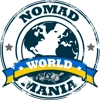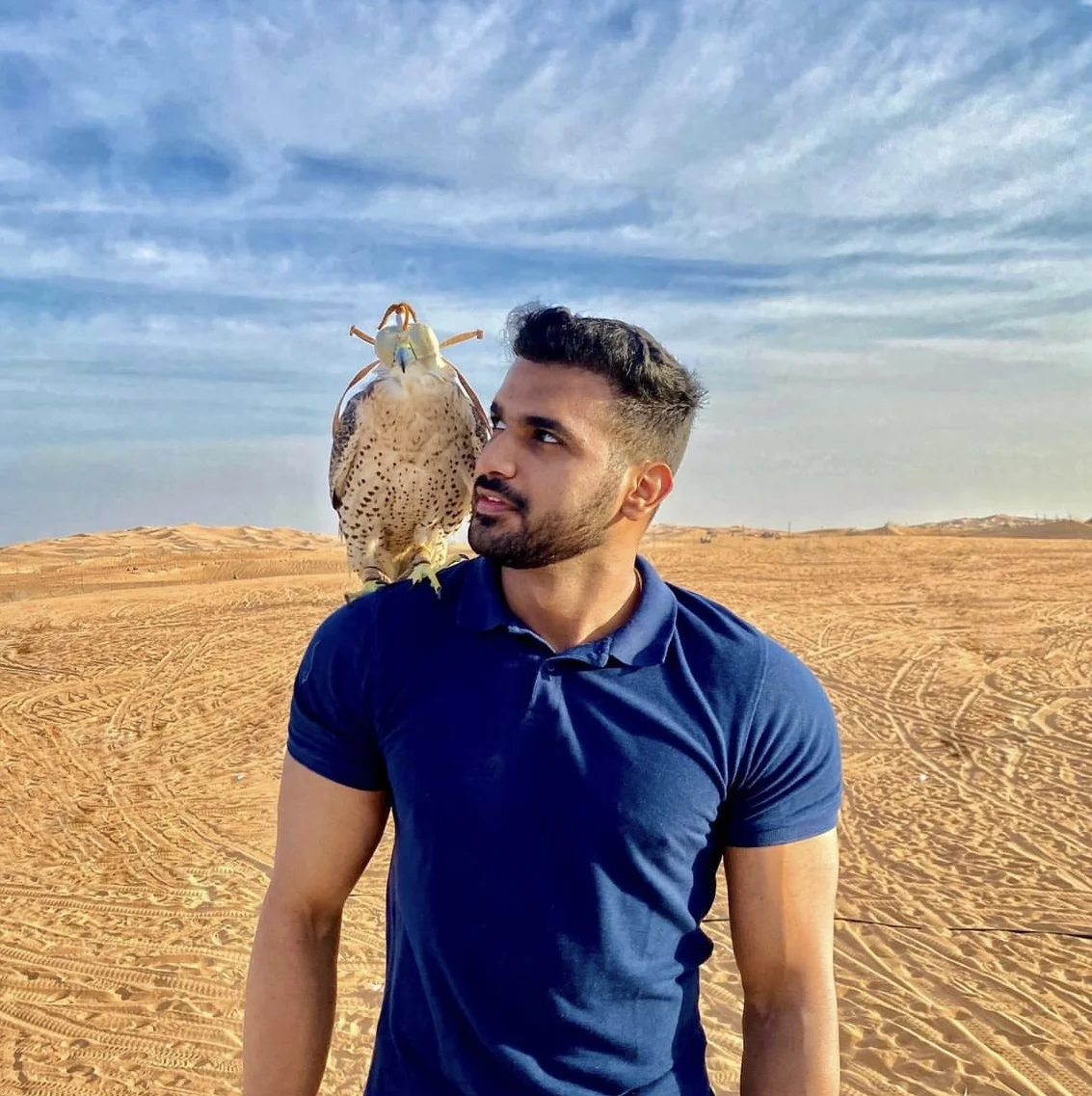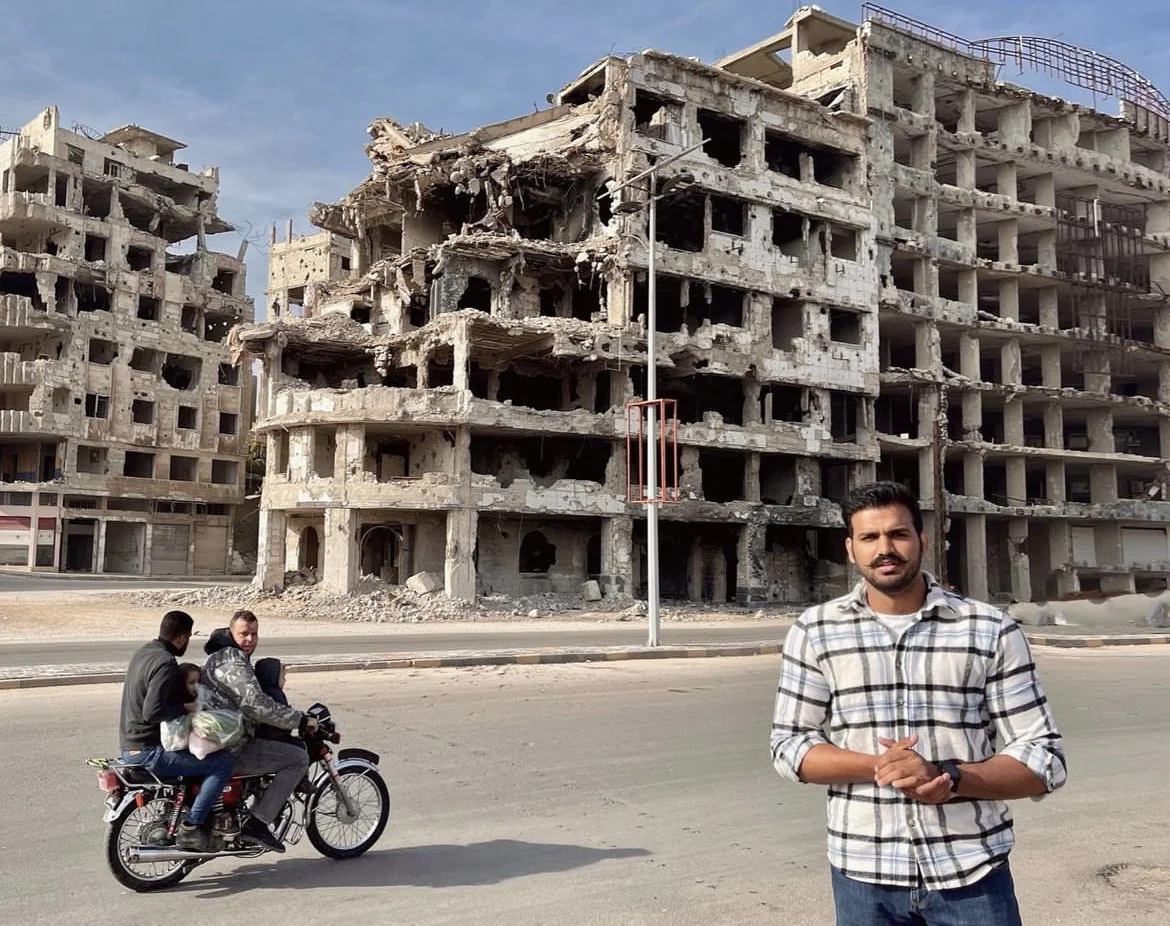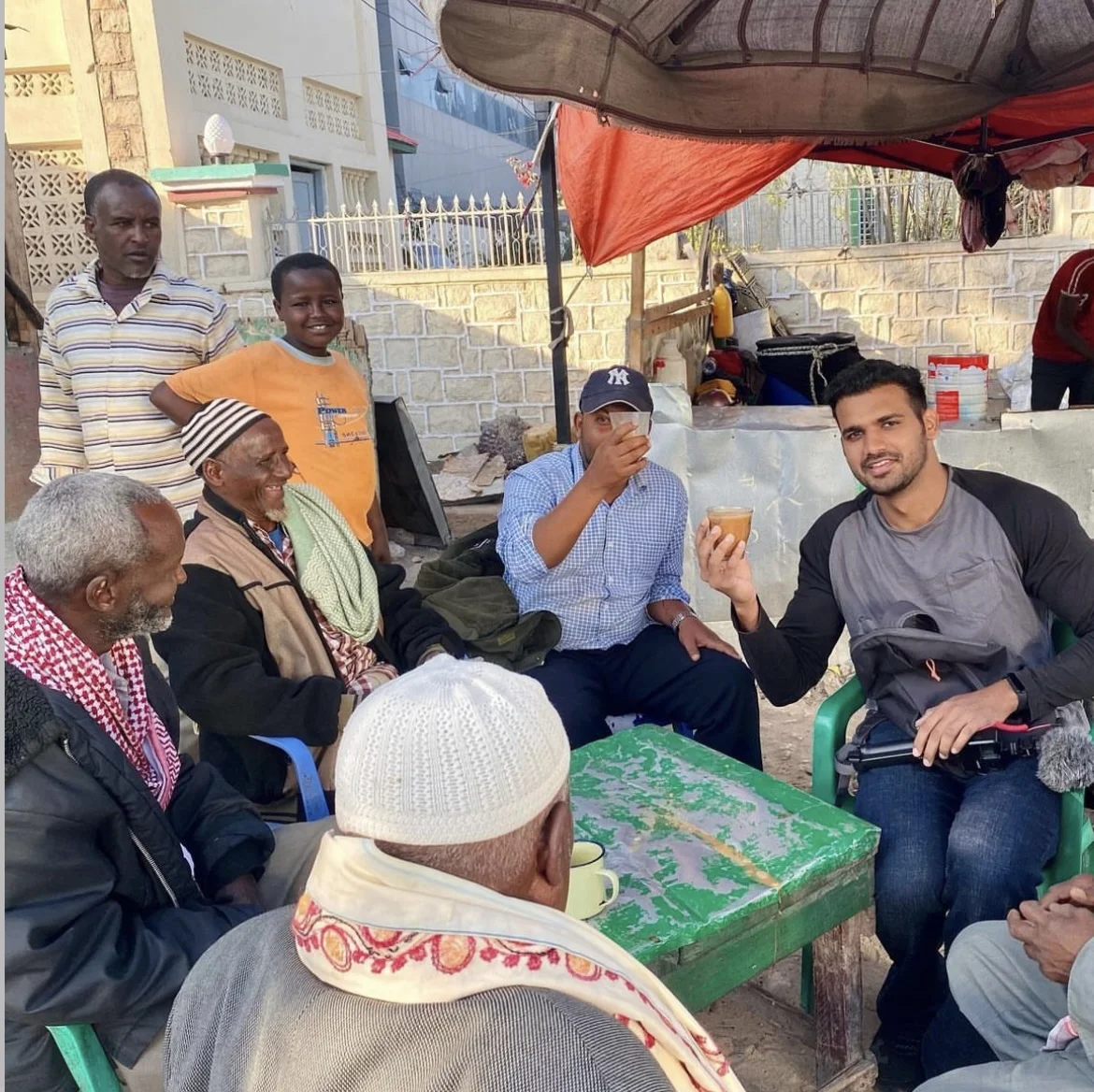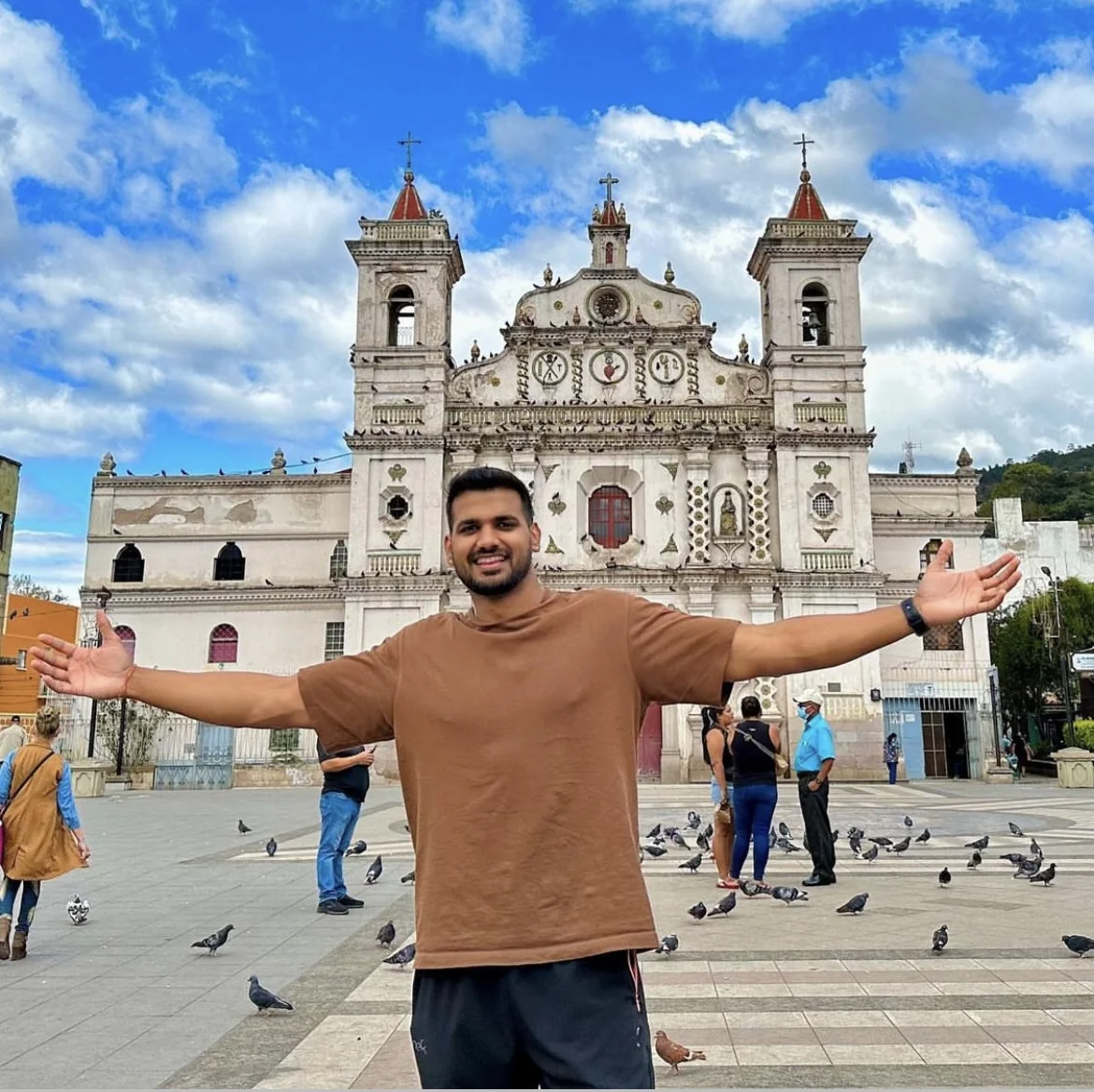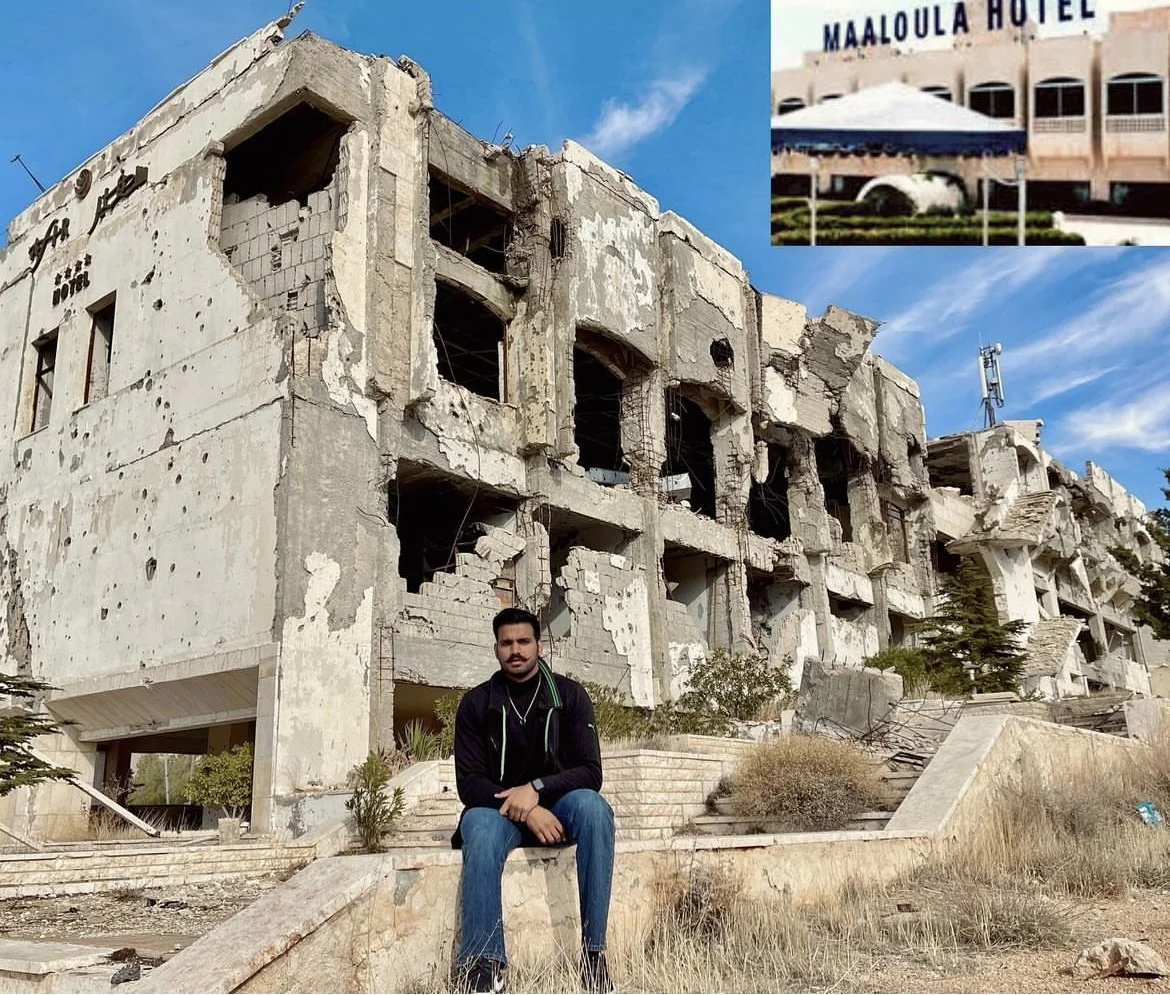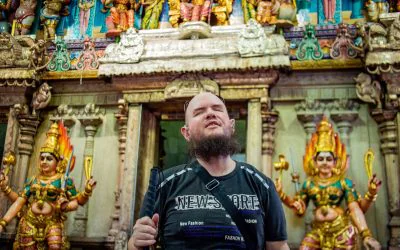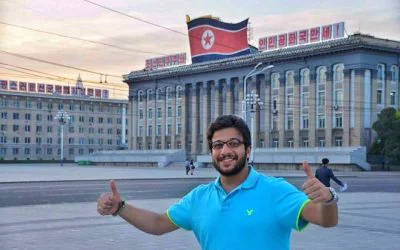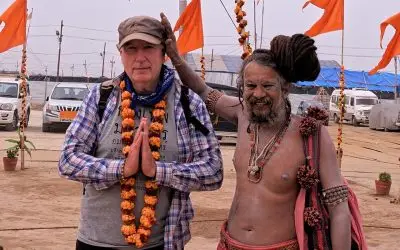Meet Paramvir Singh Beniwal, an intrepid traveler from India who has explored around 70 countries, defying the limitations of his Indian passport. His passion for travel ignited during an internship in Turkey in 2017, leading him to discover hidden gems and unique experiences in unconventional destinations.
As one of the biggest Indian Travel YouTubers, Paramvir shares captivating content featuring people, culture, landscapes, and more. Join us for an exclusive interview with this adventurous soul, as he reveals his journey, challenges, and the impact of his inspiring videos on fellow travelers. Join a chatty and exciting conversation between Paramvir and interviewer, Orest Zub
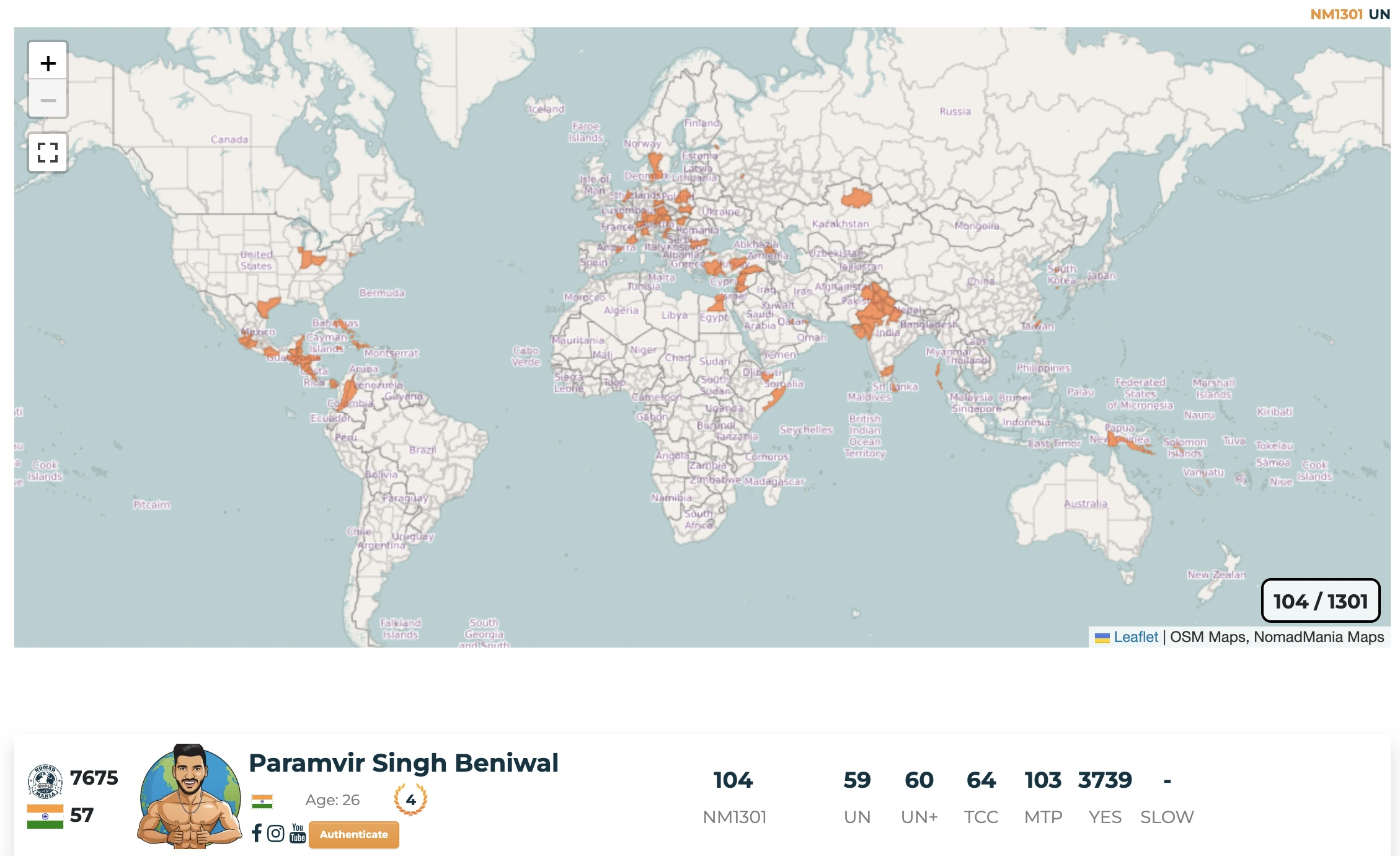
This interview is also available in video format on our Youtube channel.
Where are you at the moment? I see you have a pretty rustic and interesting background.
I’m at my home in the capital city of India, New Delhi, in a neighborhood called DLF Capital Greens. I’m sitting inside my room, here in New Delhi, India.
Wow, wow! You know, India and New Delhi, especially, have a big place in my heart because when I was roughly your age, even a little bit younger – in my early 20s, I spent half a year in India as a law intern. So that was quite the experience, all the way back in 2010, and I remember a lot of things. I think the India now is probably a different place compared to the way I remember it.
I think it’s still very intense, very chaotic, very diverse, but I think it has grown a lot technologically because everything is now digital, and the internet is super cheap here, so I think it has developed a lot.
I have no doubt about that, especially seeing how diverse the Indian travel community has become recently. At NomadMania, we have many interesting travellers, and you definitely stand out among many of those.
That’s why I actually contacted you and wanted to interview you about your travels, about your work and about your participation in the travel movement, especially in your own country because you are talking in Hindi even on your YouTube channel.
Yeah, I do talk in Hindi, exactly.
So, let’s start with the roots. You are now only 26 years old. And at this time you have visited approximately 70 countries, if I’m not mistaken. That’s a pretty significant amount of places to visit with the Indian passport. Can you tell me how did you start? How did all your passion and drive for traveling start?
So, I get asked this question quite a lot. It all started in 2017, I would say, although my first trip outside India was to the US back in 2015. But I have family there, so I never got this cultural shock of getting into a new country. However, in 2017, I went to Turkey for an internship with an organisation, and I stayed in a city called Antalya, a very beautiful city.
I was there for around two months, and during that internship, I met a lot of people from different corners of the world – people from Russia, Italy, Dubai, Egypt, Morocco – and people were speaking so many languages. I was so impressed by this culture of traveling and seeing the world. I realised that the world is very diverse, yet everyone is so similar. That actually helped me make up my mind to travel more often and to see more parts of the world. So, it was that trip to Turkey in January 2017, that made me realise my passion and love for traveling, and that’s when I started to travel more frequently.
May I ask if it was an AIESEC internship?
Yes, it was!
Why I’m asking this is because I went to India with an as well. AIESEC is the largest student organization in the world, which offers different international internship opportunities for people.
That’s right! So, do you remember which AIESEC it was, because in New Delhi, there are two AIESECs – one in Delhi IIT and one in Delhi University?
I don’t remember. It was probably not connected to the university, so it was a different AIESEC.
So everything started for you from the student exchange experience, and Turkey became the big place where all your hunger for travel began, right?
Yes, exactly! Just like you said, before, as an Indian, we didn’t have this culture of traveling the world. Yet, in the last two to three years, it has changed drastically after the use of social media and the internet. But previously, we never had this culture of traveling to different corners of the world.
Turkey, I would say, is very close to my heart. As a traveler, everyone has their own preferences for what they seek when they travel. For me, it’s always the people, the local people, the hospitality, the food, the culture, the landscape, nature – a mix of everything. I think Turkey is the best place that has the best of all these things.
The nature is amazing, the people are amazing, the food is amazing. I think Turkish food is only second to Indian food. Everything is amazing about Turkey. I fall short of words when I talk about Turkey. It’s so beautiful; the people are so nice. This place is so close to my heart. I went there in 2017 for the first time, and after that, I think I’ve traveled 33 or 34 more times, and I’ve spent like six or seven months in the country. Turkey is by far my favorite country.
I can absolutely share your opinion. Also geographically, it’s located very centrally in the world, so basically, when you travel between the continents, there is a big chance you will transfer through Turkey.
Yes, it’s in the centre of Africa, Europe, and Asia, so it connects all three continents quite well.
Cool! So, let’s take a look at your map on your Nomad Mania profile. I’m just curious to see more.
What I see here is that out of all the regions, you spent a significant amount of time densely traveling in Central America. So, before I ask you about this experience in Central America, I will just state an interesting statement that we practice in Nomad Mania – “Show me your map, and I will tell you who you are.” So basically, by looking at the map of a person, it’s possible to tell a lot about the traveller. The fact that you traveled to many different countries at a young age says a lot, and that caught my attention. Why Central America so densely?
If we talk about a country, I would say Turkey is my favorite country. But if you talk about a group of countries or a particular region of the world, or maybe a continent, I would say my favorite region of the world or my favorite group of countries is this part of the world – Central America. Being an Indian I didn’t think i would have this much fun in this part of the world and a lot of locals haven’t seen an Indian traveling to this part of the world so everyone treated me very differently. I got special attention from all the locals so it was very special, people were so excited to see me someone to come to this part of the world from the other other part of the world.
Number two, the countries are very cheap, the food is amazing and I like that it’s just a mix of everything just like Turkey. These countries are very beautiful, very underrated. Mexico has already gotten the attention that it needed while the other countries like Honduras, El Salvador, Guatemala are rising pretty fast in recent years but I think El Salvador and Honduras to be more specific, are very underrated. These are countries that most travelers avoid because they’re considered to be dangerous but I think things have changed and if you are smart enough to travel to these countries I think these these places are just amazing, its so cheap, people are so friendly you get so much attention from everyone. The food is amazing, I’ve had the best time times of my life in Central America, it was by far my favorite trip out of all the trips I’ve had before in the past, it’s just amazing.
Oh wow well you have praised the Central Americans so much that this part of the video can be viral in the Latin American World.
(laughs) I hope that these countries get the attention that they deserve and I would be happy if that happens
Many people consider Latin American countries, especially Central American countries quite dangerous because of the street violence and everyday crime is possible
Of course! We can’t ignore the facts. That’s true, I mean crimes happen and things happen so that is very true. You just have to take your own care and if you are dumb enough, then every place is dangerous for you even New York is dangerous for you. Just be smart enough just be the act normally
But beside Latin America and other places, you’ve visited some countries which are considered to be really really dangerous in the world and you even made some videos about these. I also see that there’s a video about the most dangerous tribe.
Yeah, that’s it in Ethiopia
So can you tell us about like your experiences of visiting countries which are considered to be dangerous on a global scale mostly from a political standpoint ?
I’ve found that many countries perceived as highly dangerous are, in fact, some of the safest places for travelers. While I won’t deny the presence of terrorism or crime, from a traveler’s perspective, the locals are incredibly generous and hospitable. Due to the ongoing conflicts, these regions seldom see tourists. So, when locals encounter a visitor, their happiness and generosity are overwhelming.
In Syria, shopkeepers often refused to accept money from me simply because I was a foreigner. Their warmth and hospitality was overwhelming, especially considering many were struggling financially and sometimes couldn’t even afford their daily meals. Yet, they remained generous towards a traveler from India visiting their homeland.While it’s unfortunate to say, the prevalent crimes in these regions are incidents like bomb blasts and suicide bombings. When such incidents occur, the casualties are usually numerous. If I were in a downtown area during a blast, it wouldn’t be a targeted attack on me as an individual; everyone in the vicinity would be at risk. This is in contrast to some other countries where foreigners might be specifically targeted for muggings or held at gunpoint. Personally, I find those situations where I might be individually targeted more daunting.
In some regions of Latin America or perhaps Africa, you might be targeted specifically in certain areas. However, in countries that are war zones, you don’t typically get singled out by a particular group or individuals. Surprisingly, I felt more at ease walking around downtown Damascus or Mogadishu than I would have felt strolling after midnight in Medellin, Colombia, or Tegucigalpa, Honduras. The distinction lies in the perception of danger. When you believe that if something bad happens everyone around you would be equally at risk, the fear feels distributed. But when you think you might be singled out, the sense of danger intensifies.Although these countries may have their dangers — and we can’t overlook that — the individuals I’ve encountered, especially in places like Syria, have been among the most hospitable I’ve ever met. My inclination to visit these unconventional destinations stems from the fact that they see fewer tourists. Those communities deserve recognition and acknowledgment for their warmth and generosity. This is why I appreciate traveling to these so-called “war zones”; to highlight the genuine goodness of people in these regions.
Those are insightful points. Just for clarification, when you were in Mogadishu, did you explore on your own, or was it part of an organized tour? Were you accompanied by an armed group?
In Mogadishu, I had security guards accompanying me. However, in Somaliland and Damascus, I explored solo. There were instances in Mogadishu when I’d request the guards to remain in the car and just watch from a distance. I wanted to interact with the locals independently, and I noticed they tended to be more reserved when armed personnel were visible. So, at times, I preferred the guards to be nearby for safety, but not directly with me the whole time.
I fully understand your perspective on the perceived security in various countries. For instance, my most dangerous travel experience was in Mexico when I was held at gunpoint. Yet, I live in Ukraine, which is currently experiencing one of the most significant military conflicts since World War II. Despite this, where I’m situated in the western countryside of Ukraine, it feels entirely safe. There’s a misconception about war zones; people often imagine continuous conflict, but that’s rarely the whole picture.
This brings me to our connection over Ukraine. Last year, you explored the border area between Ukraine and Poland during a significant refugee crisis. I recall inviting you to Ukraine during our discussions. What kept you from visiting, and how was your experience in the areas you did explore?
I wanted to come to Ukraine so badly, I even want to come right now. Last year in August, I was in Europe. My Schengen visa was set to expire on the 30th of August, and by the 24th, I was in Spain. I had been coordinating with a non-governmental organization in Ukraine that assists those affected by the war. I had planned to volunteer with them and support locals impacted by the conflict or those seeking to migrate to Europe
“I had a strong desire to visit Ukraine, and that feeling persists even now. During my time in Europe, I faced a logistical challenge. My Schengen visa was nearing its expiration on the 30th of August. On the 24th, while in Spain, I got in touch with a Ukrainian non-government organization. They were assisting those affected by the war, and I wanted to volunteer with them, to help locals impacted by the conflict or those attempting to migrate to Europe.However, given the situation, the only feasible way for me to leave Ukraine would have been to re-enter Europe and catch a flight out. Since the airport in Kiev was non-operational, crossing back through countries like Poland, Moldova, or Romania was necessary. By the 25th or 26th, I had reached Krakow and swiftly made my way to Shama Shul in the east, situated close to the Medika border crossing with Ukraine. So, there I was, stationed in this border town, awaiting a green signal from the organization.
Then the girl said that, due to my Indian nationality, I would require a visa to enter Ukraine. Beyond just the visa, there were additional permissions needed due to my passport. The organization was in the process of arranging the necessary paperwork for me. Although they mentioned it could take anywhere from a day to a week, I waited for several days without receiving any confirmation. Considering the impending expiration of my Schengen visa on the 30th of August, I had to prioritize my return to Berlin and subsequently exit the Schengen area. The stipulations of my visa mandate that I return to India each time I need to apply for a Schengen visa. So, the imminent expiration of my European visa was the primary reason I couldn’t proceed to Ukraine.
I completely understand your situation; it boiled down to paperwork issues. Know that you’re always welcome in Ukraine, and I can help with the necessary invitations. Moving on, you travel with an Indian passport, which can be challenging given the visa requirements for many countries. On NomadMania, we even have a Low Passport Index to recognize individuals from countries with restrictive passports who still achieve remarkable travels. You’d likely rank high on that list. Could you share your experience navigating global travel with an Indian passport? Many people feel limited by their passports, but your story could serve as motivation for them to push beyond these limitations.
I proudly hold an Indian passport, having been born in India. India doesn’t permit dual citizenship, so even if I wanted a passport with broader access, I’d have to relinquish my Indian citizenship, which I’m not willing to do. While I’m proud of my heritage, traveling with an Indian passport presents challenges. It requires me to obtain visas for almost every country I visit. Even when visas are not required or are available on arrival, I often face intensive scrutiny by immigration officers, sometimes leading to interrogations. This is because the Indian passport isn’t perceived as strong. To travel to Europe, for instance, I must apply for a Schengen visa from my home country.
Those were serious words of wisdom. Because there are international agreements between countries, the hierarchy of difficult visas is strong. When countries from the second tier see that someone has an American visa, they probably think, “This person went through all the checks, so we can be sure.” You share your stories, travel tips, and experiences on your YouTube channel, which is significant. It’s one of the biggest Indian Travel YouTube channels. Can you talk about your professional path as a creator and influencer? What’s your style? How do you develop content? What matters to you? Which topics do you emphasize to make your content visible and useful?
My unique selling point is traveling to unconventional places — destinations that Indians typically don’t frequent. Although I’m from India, I’ve never visited Southeast Asia countries like Thailand, Malaysia, or Singapore. These are popular destinations for many Indians. While I’ve traveled to 70 countries, I’ve intentionally avoided the most common ones where Indians usually go. I’ve always been drawn to lesser-known gems worldwide. As mentioned earlier in our conversation, I prioritize showcasing people, culture, hospitality, landscapes, and the affordability of places. In my content, I strive for a balanced presentation. My videos offer glimpses of nightlife, religious practices, ethnic groups, culture, food, transportation tips, cost factors, historical contexts, geographical insights, and intriguing facts about each country.
Landscapes, nature, and some adventure — I try to include a mix of everything that personally interests me. I gravitate towards destinations that aren’t typically visited and those I’m genuinely curious about. That’s my unique style. Fortunately, I’ve gained much love and support from many Indians. Their support has been instrumental in helping me fund and sponsor my travels, which I’m deeply grateful for.
Oh wow, so you’re making videos, traveling around the world, and earning a living from it. While I think I have an idea of what you’re doing, could you explain for those who ask you daily how you manage to make a living out of it?
Okay, so I’ve actually made a course on this as well. I recently launched the course. I’m not asking people to buy my course, but I wanted to mention that I’ve discussed the same things there. Specifically, I’ve talked about how you can get paid to travel the world. One of the main topics is the blogging category, which is what I’m doing.
So, when you post a video on YouTube, like, let’s say I post this video about Poland, you might see these random ads on the video with the “skip ad” option. These ad companies pay money to YouTube for these ads. YouTube takes a cut, which is 45%, and then 55% of what the company pays YouTube goes to the creator who posted the video.You, as the content creator, can’t decide how much a brand is going to pay YouTube because it depends on several factors: the geography of your audience, the age range, the gender, how long they watch the ad, and more. YouTube decides how much they’re going to charge the ad company based on these factors.This kind of revenue is called “platform revenue”, and it varies for every platform.
Instagram has different platform revenue, YouTube has a different structure, and Facebook has its own rules. To access the platform revenue, you need to get your channel, social media, or travel brand monetized, and each platform has its own monetization criteria. Just like on YouTube, where you need to have at least 1,000 subscribers and at least 400 hours of watch time in the last year, Instagram has its own criteria. Once you get monetized on the platform, it pays you depending on how many views you’re getting.
On top of that, there’s brand marketing or sponsorships as well, where creators like me promote a brand. Let’s say, for example, this is Biscillary Water. In this case, the company would directly contact me. They would email me, and my manager would negotiate the price and everything. I would promote this water company for 60 seconds and would charge a specific amount from the company, usually like 1,200 US dollars for 60 seconds. That’s what I usually charge. But so, this company got free promotions right now. These are the two main ways to get paid from social media.
Many people don’t realize that it’s actual work. It requires dedication and discipline all the time. I’ve noticed that you’re not only putting a lot of effort into your material, but you’re also taking care of your body and soul. You’re in great shape, and keeping in such shape while actively traveling is a significant challenge. What are your routines? What do you do to stay in such great shape?
Being in shape while traveling is both easy and challenging. It’s easy because you’re burning off a lot of calories; walking all day and carrying your backpack makes it hard to gain weight. However, it’s challenging because in this process, you can lose muscle mass due to not getting enough calories and protein. My usual routine involves trying to find a gym. I love weight training, so I aim to go to a gym at least three to four days a week. I take day passes in every city I’m in. With the growing gym culture, you can find gyms in almost every city and even small villages around the world. When I find one, I just get a day pass and work out.
I try to do this as much as I can during the entire week, but usually, it’s like three to four days of weight training at the gym. If I am at a place where I can’t find a gym, or the gyms are super expensive, then I just stay indoors. I do weight training with my bags; I load them up with some groceries and everything to make them heavier, and I do some weight training with my bags. Talking about cardio, when you’re traveling, you’re already doing a lot of cardio when you’re walking with the bags and everything, so there’s no need for additional cardio training. It keeps your heart healthy and doesn’t let you get fat.
Apart from this, talking about the diet, the best things, as a traveler, that you can have—the most nutritious and the cheapest sources of proteins, fats, and carbs—would be milk, peanut butter, and eggs. These are the cheapest sources; you’d find them everywhere in every corner of the world. You would get a lot of proteins and fats from these and then some carbs as well. So I usually go for grocery shopping wherever I am.
Same here. I buy peanut butter, but now that I can afford it, I opt for almond butter instead. I also purchase eggs, and since I’m from the northern part of India where dairy is a significant part of our diet, milk suits me quite well. I usually get one or two litres of milk, some eggs, almond butter, and maybe some bread. This way, I’m getting all the amino acids and all the macronutrients. Additionally, I buy seasonal fruits for vitamins, minerals, and fiber. If I feel I haven’t gotten enough protein, I also carry some whey protein with me and take a scoop when needed. That’s typically what I do.
Sounds like you have a similarly scientific approach and really know what you’re doing. It’s essential to understand and feel what you digest. May I ask, when you travel, you often meet people and there are parties—it’s almost like a constant festival mode when you’re on the move. Do you drink? Do you consume alcohol?
Yes, I do drink alcohol but very occasionally. I avoid hard liquors and usually stick to beer—only beer. However, if I feel like letting loose for the day, I might indulge more, but I always try to drink in moderation. The frequency varies based on the country. For instance, if I’m in Colombia or Mexico, I might drink more compared to when I’m in a Middle Eastern or Arabic country. Over the past year, I’d estimate I’ve had drinks on maybe 15 to 20 occasions, so on average, I drink about once every two weeks or so. That seems pretty moderate to me.
You know what? I believe we could talk for hours, but we have to wrap things up. All of us are pretty busy and so on. But there’s always a signature question we ask our guests on Nomad Mania, and it’s the following: If you had a chance to meet any three people, either from history or currently living, whom would you invite for dinner and why?
That’s an intriguing question. To be honest, there isn’t a specific person I can name. When I’m traveling, it would likely be my family. I always miss them, and the opportunity to have dinner with them would be fantastic. Travelers like us are often away from home for extended periods. However, since I’m currently home and have the luxury of eating with my parents daily, I won’t name them in this context.
While I can’t pinpoint specific names, I’m deeply interested in engaging in extensive conversations with those who’ve traveled more extensively than I have, like you, or polyglots. I’m always so impressed with individuals who speak multiple languages. So, anyone who’s a polyglot or has seen more of the world than I have would be an ideal dinner companion. I’d be truly honored to dine with them. While I can’t list three particular names, one could be you, and the others could be anyone from NomadMania with more travel experience than me.
